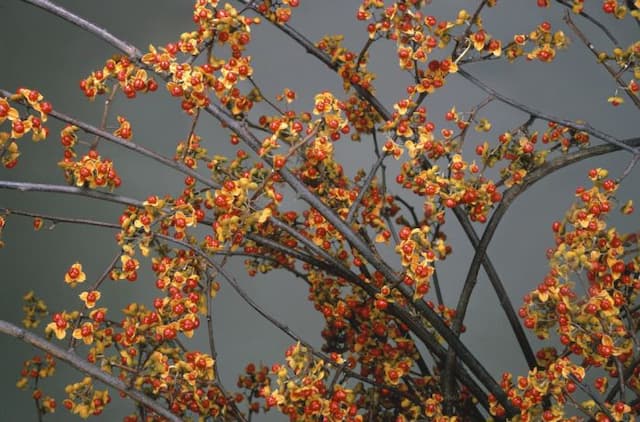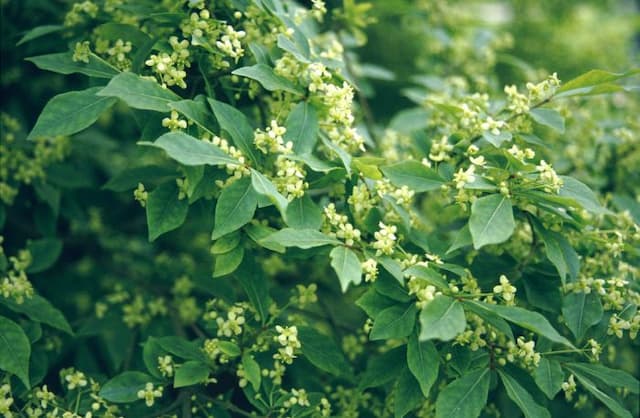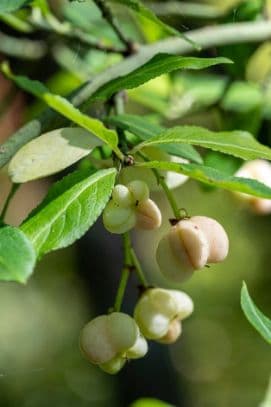Sasha Berry Euonymus planipes

ABOUT
The plant known as the Spindle Tree, with the name Euonymus planipes, is a deciduous shrub noted for its attractive features across all seasons. It bears broad, oval-shaped leaves which have finely toothed edges, boasting a rich green color during the growing season. As the colder months approach, the leaves undergo a stunning transformation, taking on hues of red, purple, or sometimes a fiery orange, providing a striking display of autumnal color. Come springtime, the Spindle Tree showcases small clusters of greenish-yellow flowers. These blooms might not be particularly showy, but they add a subtle charm to the plant's springtime appearance. As the flowers fade, they give way to a very distinctive feature for which the plant is well-loved: its fruits. The fruit is a bright pink capsule that splits open to reveal seeds encased in a bright orange aril, which stands out against the foliage and persists into the winter, adding interest to the barren landscape. The Spindle Tree also exhibits a pleasing form, with a multi-stemmed habit that can create a dense bushy appearance. It has a rounded to flat-topped canopy that further enhances its ornamental value in a garden setting. The bark and twigs are typically gray to brown, which provides a subtle backdrop for the more colorful aspects of the plant. The appearance of this plant throughout the year with its seasonal transformations make it a valuable addition to a garden for its aesthetic appeal.
About this plant
 Names
NamesFamily
Celastraceae
Synonyms
Sachalin Spindle Tree, Flat-stalked Spindle Tree, Siberian Spindle Tree, Spindle Tree
Common names
Euonymus sachalinensis, Kalonymus sachalinensis, Euonymus planipes var. sachalinensis.
 Toxicity
ToxicityTo humans
The Spindle Tree can be toxic if ingested by humans. Parts of the plant, including seeds, leaves, and bark, contain compounds such as alkaloids that can be poisonous. Symptoms of poisoning may include nausea, vomiting, abdominal pain, diarrhea, and weakness. Ingesting larger amounts can potentially lead to more severe symptoms like changes in heart rate, coordination problems, and convulsions. It is essential to seek medical attention immediately if poisoning is suspected.
To pets
The Spindle Tree is also toxic to pets, such as dogs and cats. The toxic principles are similar to those affecting humans, with the seeds, leaves, and bark containing compounds that can cause harm if ingested. Symptoms of toxicity in pets may include vomiting, diarrhea, weakness, changes in heart rate, and, in severe cases, seizures or muscle tremors. If you suspect your pet has ingested any part of the Spindle Tree, contact a veterinarian promptly.
 Characteristics
CharacteristicsLife cycle
Perennials
Foliage type
Deciduous
Color of leaves
Green
Flower color
Purple
Height
15 feet (4.57 meters)
Spread
15 feet (4.57 meters)
Plant type
Shrub
Hardiness zones
4
Native area
Asia
Benefits
 General Benefits
General Benefits- Decorative appeal: The Euonymus planipes, commonly known as Spindle Tree, has striking fall color and distinctive fruits that add visual interest to landscapes.
- Wildlife habitat: Its fruits provide food for birds and small mammals, while the dense foliage offers shelter and nesting sites.
- Drought resistance: Once established, the Spindle Tree is relatively drought-tolerant, requiring minimal watering in suitable climates.
- Low maintenance: Euonymus planipes generally requires little pruning or care, making it a convenient choice for gardeners seeking low-effort plants.
- Soil adaptability: This plant can thrive in a variety of soil types, making it versatile for different garden conditions and locations.
- Cold hardiness: It can tolerate cold temperatures, which enables it to be grown in regions with harsh winters.
 Medical Properties
Medical PropertiesThis plant is not used for medical purposes.
 Air-purifying Qualities
Air-purifying QualitiesThis plant is not specifically known for air purifying qualities.
 Other Uses
Other Uses- Wildlife Habitat: The Spindle Tree provides a nesting site and protection for birds and small mammals.
- Natural Dyes: The bark and fruit have been used to create dyes for fabric and crafts.
- Woodworking Material: The fine-grained, hard wood of the Spindle Tree is suitable for making small craft items and tool handles.
- Winter Interest: With its bright red fruits and pink capsules, it offers aesthetic value to gardens during the dull winter months.
- Hedges and Screens: Due to its dense growth habit, it can be used to create privacy hedges and windbreaks in landscapes.
- Bonsai: Its attractive form and colorful fruits make it a suitable candidate for bonsai cultivation.
- Photography Subject: Because of its vibrant appearance, especially in the autumn, it is a popular subject for nature photographers.
- Educational Resource: Schools and nature programs use the Spindle Tree to teach about native plant species and their ecological roles.
- Soil Stabilization: It can be planted on slopes and banks to help prevent soil erosion and slippage.
- Cultural Symbolism: In certain cultures, the Spindle Tree may have symbolic meanings and is incorporated into traditional practices and ceremonies.
Interesting Facts
 Feng Shui
Feng ShuiThe Spindle Tree is not used in Feng Shui practice.
 Zodiac Sign Compitability
Zodiac Sign CompitabilityThe Spindle Tree is not used in astrology practice.
 Plant Symbolism
Plant SymbolismEuonymus planipes is commonly known as the Spindle Tree. Here is the symbolism associated with it:
- Protection: In some cultures, Spindle Tree wood was used to make spindles for spinning wool, which was an essential, life-sustaining activity. This association with the spindle, an everyday tool, can symbolize protection of livelihood and home.
- Safe journey: Being an important part of the wheel-making process in the past, the Spindle Tree can represent the wish for a safe journey, symbolizing the wheel's role in transportation and steady travel.
- Transformation: The Spindle Tree often displays vibrant autumn colors, suggesting a symbolism of change and transformation as it shows a striking transformation from season to season.
- Inner Strength: Despite its relatively small size and delicate flowers, the Spindle Tree can grow in challenging conditions, representing the quiet, resilient strength.
- Poison: As parts of the plant are toxic, it can symbolize caution or hidden dangers, a reminder to be aware of unseen risks or to maintain boundaries.
 Water
WaterThe Spindle tree should be watered thoroughly, allowing water to penetrate the soil to a depth of a few inches. During the growing season, water the Spindle tree with about 1 to 1.5 gallons per week, adjusting for rainfall, as the soil should be kept moist but not waterlogged. Water the plant slowly to ensure the moisture reaches the root zone. In winter, reduce watering but do not let the soil completely dry out. Always check the top inch of soil for dryness before watering; overwatering can lead to root rot.
 Light
LightSpindle trees thrive best in full sun to partial shade. They should be placed in a location where they receive at least four to six hours of direct sunlight daily. However, in regions with very hot summers, providing some afternoon shade will help prevent leaf scorch.
 Temperature
TemperatureSpindle trees can tolerate a wide range of temperatures but prefer a climate with temperatures between 50°F and 75°F. They can survive minimum temperatures down to about 20°F and maximum temperatures approaching 90°F. For best growth, avoid exposing the Spindle tree to conditions where temperatures drop below 20°F or soar above 90°F.
 Pruning
PruningPrune Spindle trees to maintain shape and encourage bushier growth, as well as to remove any dead or diseased wood. The best time for pruning is in the late winter or early spring before new growth begins. Pruning every year or every other year is generally sufficient to keep the tree healthy and well-shaped.
 Cleaning
CleaningAs needed
 Soil
SoilFor the Spindle Tree, the ideal soil mix should be well-draining, composed of loam and organic matter, with a pH ranging from 6.0 to 7.5 to match its natural woodland environment.
 Repotting
RepottingSpindle Trees do not require frequent repotting and should be repotted every 2 to 3 years, or when the plant has outgrown its current pot.
 Humidity & Misting
Humidity & MistingThe Spindle Tree does well in moderate to high humidity levels, which mimic its native habitat, but it is also tolerant of the lower humidity levels typically found in home environments.
 Suitable locations
Suitable locationsIndoor
Place in bright indirect light, ensure good air circulation.
Outdoor
Plant in partial shade, protect from strong winds.
Hardiness zone
4-9 USDA
 Life cycle
Life cycleThe life cycle of Euonymus planipes, also known as the Spindle Tree, begins with seed germination, which occurs in the spring after stratification, as the seeds require a period of cold to break dormancy. Seedlings emerge and grow into juvenile plants, developing a root system and foliar structure primarily during the warmer seasons. The plant then matures over several years, forming a deciduous shrub or small tree that can reach up to 6 meters in height, with distinctive greenish-purple branches. During the reproductive stage, the Spindle Tree produces small greenish flowers in the summer that are not particularly showy. These flowers are succeeded by bright pink to red fruits with orange seeds, which typically appear in the fall and can persist into winter, providing ornamental value and facilitating seed dispersal. As a perennial, the Spindle Tree undergoes cycles of growth and dormancy annually, with leaves turning various shades of red before shedding in the autumn.
 Propogation
PropogationPropogation time
Late winter-early spring
The most popular method of propagating the Spindle Tree, specifically Euonymus planipes, is through its seeds. Propagation by seed typically takes place in the fall after the spindle tree fruits have ripened and the seeds are collected. The seeds must be cleaned and then subjected to cold stratification, which involves chilling the seeds in a refrigerator for approximately 90 to 120 days to simulate winter conditions, a process necessary for germination. After cold stratification, the seeds are sown in pots or trays filled with a well-draining soil mix and kept moist until germination occurs, usually in the spring. Seedlings can then be transplanted into the garden once they are large enough to handle and after the danger of frost has passed.




![Spindle [Blondy]](/_next/image?url=https%3A%2F%2Fplants-admin.emdemapps.com%2Fimages%2Fplants%2F%2Fimages%2F604b642f54add.png&w=640&q=75)



